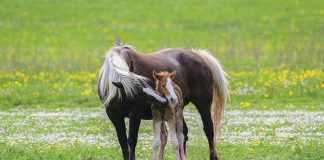
For your horse’s skin health, whether or not you choose to ride during the winter should not impact your regular grooming routine. Horses benefit greatly from daily grooming, and in the winter, this is an excellent way to warm yourself up. Grooming also allows you to take a close look at your horse and find minor scrapes and bumps that can hide in a winter coat.
Continue to schedule routine farrier visits throughout the winter. Long, untrimmed hooves are havens for bacterial growth, and overgrown feet more easily collect snow and ice, making it difficult to walk.
Consider having your horse go barefoot in the winter if your area receives a lot of snow, since horseshoes decrease your horse’s traction. In cases where a horse’s feet are too sensitive to walk on hard-packed snow without shoes, your farrier may recommend adding snow pads. These will prevent snow and ice from balling up under the hooves. If you plan to ride extensively outside in snow and ice where traction might be an issue, having your farrier add some borium (tungsten carbide) to the toes and heels of the shoes is another option.
Read more:
A Winter Spa Day for Your Horse
Winter Horse Shoeing
Back to Horse Health in Winter >>
This article originally appeared in the November 2014 issue of Horse Illustrated. Click here to subscribe!





